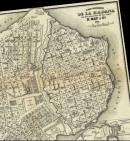- Stone Beltway.
Maybe many Havana residents from the ongoing generation, quite unaware of our history, or the foreigners that visit the city, blame on oblivion or on the rulers’ neglectfulness, that across from the Presidential Palace and the Carlos Manuel de Cespedes Avenue, there are two quasi-destroyed stone sentry boxes that can be seen from either side, or the piece of wall next to an old tree, intertwined among its ashlars, that stands on one of the sides of the Provincial Institute, or the other wall made up of thick rocks that can be made out from Egido Street, very near the modern Train Station, as well as the wall with a bricked-up door…
Emilio Roig de Leuchsenring
Havana: historic accounts (vol. I).
The Foundational Letters of the Havana City Hall -that will soon be declared World Memoirs by UNESCO- set February 3, 1674 as the date when the construction of the walls began. Identical references, harkening back to the Town Hall sessions in 1797, insist that those walls, weren’t they built then, were just about to be finished.
A closer look at the blueprint signed by the King’s military engineer Cristobal de Roda Antonelli -who tombstone, next to his wife’s, Francisca de Arellano, was found during the demolition of the former San Juan de Letran convent- perfectly reveals his idea of what a boundary wall was really like.
A few years later, different governors successively built several walls on the seaside. They were held back by the construction of the so-called “Valdes’ Curtain” by Captain General Jeronimo Valdes y Sierra (1784-1855).
Recent archeological diggings conducted as part of the restoration process of the Havana Historic Core -declared together with its fortress system as World Heritage by UNESCO back in 1982- have shown how much lied under the street layout from 1863 on, in the best interest of trade and the enhancement of the Cuban capital. It was inevitable for the burg to stretch out beyond the wall beltway built for centuries by hundreds of slaves and quarry laborers.
Today, when the Excelencias magazine wants to celebrate with several successive issues the fifth centennial of Havana’s ultimate settlement (1519) next to the like-name seaport, and the slow-but-definitive expansion of San Cristobal -founded on a spot on the south coast of the current Mayabeque province- it feels good to retake all of our endeavors in reliving a story that had barely been represented in a handful of fragments, one of the many doors, two sentry boxes and two barracks in different spots of the place they had originally been standing in.
Who knows if within the most interesting findings we can see the remains found under the foundations of the building known as Manzana de Gomez, recovered and recently opened under the name of Gran Manzana Kempinski, and located under the first floor of the lovely refurbished compound; or the astounding stamp that was virtually left at the entrance of the Cathedral Square, which in time will join what will soon be the Walls Archeological Park…































































































































